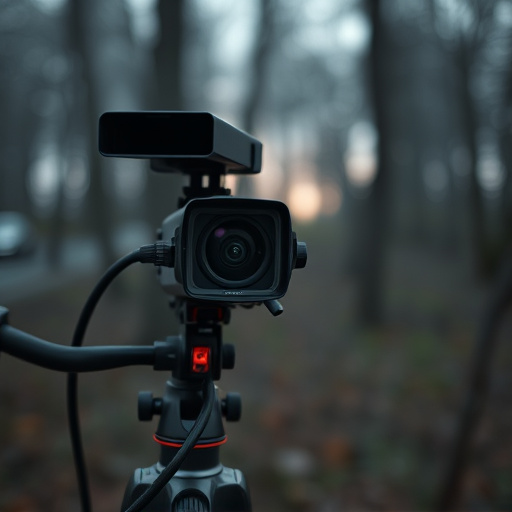Battery-powered spy cameras are ideal for outdoor surveillance due to their discreet operation, compact design, and robust build, suitable for various settings from homes to public spaces. They offer energy-efficient components, motion detection, and prolonged battery life. Nighttime glint detection is challenging but can be overcome with strategic lighting techniques, leveraging ambient light sources, careful camera positioning, and motion-activated lighting. "Implementing a Practical Solution" provides step-by-step guidance on reducing lens glint for clearer images in low-light conditions, enhancing the performance of outdoor battery-powered spy cameras.
In the age of surveillance, battery-powered spy cameras have become ubiquitous, particularly in outdoor settings. However, their effectiveness often hinges on one crucial aspect: detecting glints from lights, which can compromise covert operations. This article delves into the intricacies of nighttime glint detection for these clandestine devices, focusing on techniques leveraging outdoor lighting. We explore the challenges and offer a practical, step-by-step guide to enhance their performance, ensuring successful missions in diverse environments.
- Understanding Battery-Powered Spy Cameras: A Brief Overview
- The Challenge of Nighttime Glint Detection
- Techniques for Effective Glint Detection Using Outdoor Lighting
- Implementing a Practical Solution: The Step-by-Step Guide
Understanding Battery-Powered Spy Cameras: A Brief Overview
Battery-powered spy cameras, as the name suggests, are surveillance devices that operate on batteries, making them ideal for outdoor applications where constant power supply might be challenging to arrange. These compact and often hidden cameras offer a discrete way to capture footage in various settings, from homes to public spaces. The ‘outdoor’ aspect is crucial here, as it presents unique challenges like varying weather conditions, temperature fluctuations, and potential obstacles that require robust construction and durable materials.
Such spy cameras are designed with energy efficiency in mind, utilizing low-power components and advanced sensors to minimize battery drain. They often incorporate motion detection features, allowing them to capture footage only when necessary, thus extending battery life. This is particularly beneficial for prolonged surveillance missions or in situations where frequent manual intervention is impractical.
The Challenge of Nighttime Glint Detection
Nighttime glint detection presents a unique challenge for camera systems, especially those designed for outdoor surveillance using battery-powered spy cameras. The low-light conditions and potential reflections from surfaces like water, glass, or even wet leaves can make it difficult for sensors to differentiate between genuine objects and unwanted glare. This issue is exacerbated by the fact that many outdoor environments have varying lighting conditions, with sudden changes in illumination due to streetlights, moonlight, or even passing vehicles casting dynamic shadows.
The complexity increases when considering the power constraints of battery-operated devices, which require efficient algorithms to minimize energy consumption while still delivering accurate results. Traditional methods might struggle to adapt to these variations, leading to either false positives or missed detections. Therefore, advanced techniques are needed to navigate this landscape, ensuring that glint detection remains reliable and effective during nighttime operations.
Techniques for Effective Glint Detection Using Outdoor Lighting
Effective glint detection using outdoor lighting for battery-powered spy cameras requires a nuanced approach. The key lies in leveraging ambient light sources like street lamps, security lights, and even moonlight to illuminate subjects from indirect angles, minimizing direct reflections that cause glints. By positioning your camera lens strategically—often elevated or aimed at reflective surfaces—you can capture clear images without the distracting glare.
Advanced techniques involve understanding light intensity variations throughout the day and night. Using motion-activated lighting, for instance, ensures that lights only come on when movement is detected, reducing unnecessary light pollution and enhancing glint-free image quality. This method is particularly useful in scenarios where privacy is paramount, such as installing a battery-powered spy camera outdoors for home security or surveillance purposes.
Implementing a Practical Solution: The Step-by-Step Guide
Implementing a Practical Solution: The Step-by-Step Guide
In the quest to combat glint from battery-powered spy cameras, especially those designed for outdoor use, a practical and effective method is crucial. This step-by-step guide outlines a tailored approach to detecting and minimizing lens glint in real-world scenarios. Begin by understanding the camera’s optical design; many spy cameras employ compact lenses that can be prone to reflecting light, creating unwanted glint. Next, position your subject or target strategically, ensuring there are minimal direct light sources behind them. This simple adjustment often significantly reduces glint without any technical modifications to the camera.
For more robust solutions, consider implementing a physical barrier between the camera lens and potential light sources. This could involve using reflective material to redirect light away from the lens or employing specialized filters designed to absorb or scatter glare. In outdoor settings, natural elements like trees or buildings can provide organic barriers. If direct sunlight is an issue, positioning the camera at an angle to avoid the sun’s direct beam can be highly effective. These practical steps empower users of battery-powered spy cameras to capture clear images even in low-light conditions, ensuring optimal performance without the distraction of lens glint.
In conclusion, effectively detecting glints from battery-powered spy cameras in nighttime environments is a complex task that requires strategic outdoor lighting and practical implementation. By understanding the unique challenges posed by these devices and employing techniques tailored to external settings, we can significantly enhance security measures. The step-by-step guide provided offers a valuable resource for those seeking to protect their spaces from covert surveillance, ensuring peace of mind in today’s digital age.
